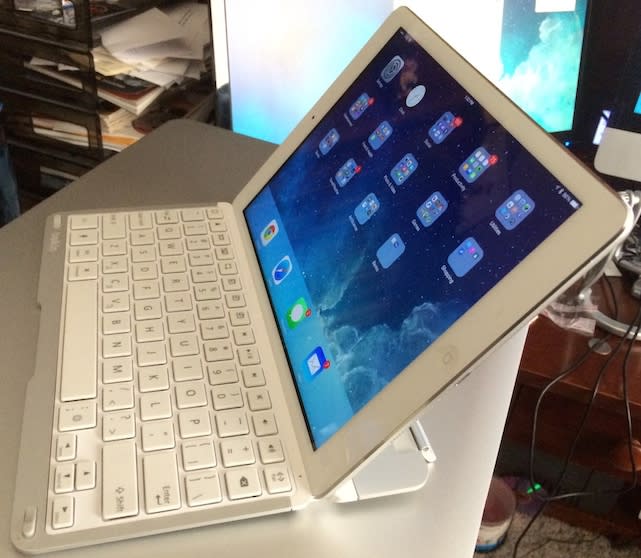Belkin's QODE Thin Type Keyboard Case for iPad Air

There's a battle raging among the manufacturers of keyboard cases for the iPad to see who can make the thinnest and/or lightest, and the most recent salvo in the war has been fired by Belkin with the new QODE Thin Type Keyboard Case for iPad Air (US$99.99). While we still haven't been able to compare it to the current generation of Logitech's similar Ultrathin Keyboard Cover (also $99.99), we were able to give Belkin's new thin keyboard a workout. How did it fare? Read on!
Specifications
Dimensions: 6.6 inches wide x 9.4 inches tall (169.5 mm x 240 mm). Thickness varies from .16 inches (4 mm) over most of the keyboard to a maximum of .39 inches (10 mm).
Weight: 12.6 ounces (357.2 grams)
Materials: Aluminum and polycarbonate
Estimated battery life: 79 hours active, 3100 hours standby
Charging cable: USB to micro-USB (included)
Design Highlights
When looking at the keyboard, the QODE Thin Type Keyboard Case is surprisingly similar in looks to the Logitech Ultrathin Keyboard Cover in that there is a horizontal slot above the keys where the iPad Air is placed. There's also a hinged piece that connects the Keyboard Case magnetically to the iPad Air as a cover (the magnets are in the iPad Air, of course). Note that the black keyboard seen in the review photos is the previous generation Logitech Ultrathin Keyboard Cove and is used for comparison purposes.
Rather than sporting power and pairing buttons on the side like the Logitech Ultrathin (previous generation), there's a small switch in the slot on the keyboard that is pressed when the iPad is put in place for typing. That switch turns the keyboard on, then shuts it off when the iPad Air is removed. There's never a need to remember whether or not the keyboard is turned off; by default, if the iPad Air is removed, the keyboard is off. For first-time pairing, there's a Pair button on the top row of keys on the QODE Thin Type.
As you'd expect, there are other design differences as well. The bottom of the Logitech Ultrathin is perfectly flat, which can make it somewhat slippery to hold. The QODE Thin Type has a "bump" across the back where the slot for the iPad Air is located, and there's also another larger bump for the battery. Those offer a bit more grip than that available on the Logitech Ultrathin.
The majority of the keyboard is less than 4 mm thick, which makes for a very lightweight and downright skinny case. Of course, the back of your iPad is bare to the world, but at least the display is covered when in transit.
The QODE Thin Type comes in two colors to match the white ("silver") and black ("space gray") iPad Air models. There is no backlight for the keys.
Functionality Highlights
I really like the idea of the automatic on/off switch. I've had situations where the Logitech Ultrathin cover has come off in a bag, turning on the iPad Air and sucking the batteries dry as it believes someone is pushing a key. That's not going to happen with the Belkin -- take the iPad out of the slot and it's off. Put it back in, and it turns on and pairs. Nice.
Belkin chose to go with somewhat larger keys on the QODE Thin Type Keyboard Case, which has both good and bad points associated with it. While the larger keys are somewhat easier to type on, their size means that some special keys are relegated to non-standard places on the keyboard. For example, the colon and semicolon are to the right of the space bar, and the greater than/less than/forward slash keys that normally take up three keys on the "z" row of a keyboard are compressed into two keys.
On the plus side, Belkin put a completely separate row of keys onto the top of the QODE for iPad special functions -- those keys aren't shared with with the number row as on the Logitech Ultrathin so there's no need to hold down the Fn key to get them to work.
For me, the primary factors that make up the rating for a keyboard cover case like the QODE Thin Type are ease of typing and protection of the display. For typing, this keyboard excels with just a few problems that occur due to the non-standard location of the keys. The keys that caused the most problems were the question mark, quotes, and colon/semicolon. The rest of the time I found myself typing quickly and accurately. The QODE Thin Type works well in your lap or on a desktop surface.
I personally found the QODE Thin Type to work better as a display cover than the last-generation Logitech Ultrathin Keyboard Cover. The magnetic latching to the hinge seems stronger, and there is less lateral movement of the cover -- that ensures that the iPad properly lines up with the keyboard and turns it on or off when you open or close the combo.
Finally, there's a feeling of solidity with the QODE Thin Type that is really surprising considering the thin and lightweight construction of the device. It just feels like it's going to hold together for a long time
Conclusion
The Belkin QODE Thin Type Keyboard Case for iPad Air has plenty of competition out there, particularly from Logitech's similar Ultrathin Keyboard Cover. The QODE, despite some odd key placement, is a worthy competitor to the last generation of the Logitech Ultrathin. The slightly larger keys and precise key response almost make up for combining other keys in non-standard ways, and the solidity of the construction is a plus. Knowing for sure that the keyboard is really shut off when the iPad Air is removed from it? Priceless.
Rating: 3-1/2 stars out of 4 stars possible


